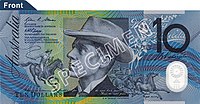Australian ten-dollar note
| (Australia) | |
|---|---|
| Value | 10 Australian dollars |
| Width | 137 mm |
| Height | 65 mm |
| Security features | Window, Watermark |
| Paper type | Polymer |
| Years of printing | 1993–94, 1996–98, 2002–03, 2006–2008, 2012–2013, 2015 |
| Obverse | |
 |
|
| Design | Andrew Barton (Banjo) Paterson |
| Designer | Max Robinson (designer) |
| Design date | 1 November 1993 |
| Reverse | |
 |
|
| Design | Mary Gilmore |
| Designer | Max Robinson (designer) |
| Design date | 1 November 1993 |
The Australian ten dollar banknote was issued when the currency was changed from the Australian pound to the Australian dollar on 14 February 1966; it replaced the £5 note which had similar blue colouration. There have been three different issues of this denomination, a paper banknote, a commemorative 1988 polymer note to celebrate the bicentennial of Australian settlement (the first polymer banknote of its kind), and from 1993 a polymer banknote.
According to Reserve Bank of Australia statistics, as at June 2016 there were 120 million $10 notes in circulation, with a net value of $1.196 billion. This was 2% of the cash value of all banknotes in circulation, and 8% of the number of all banknotes in circulation.
Since the start of issue of $10 notes, there have been eleven signature combinations, of which the 1967 issue is the most valued. It was issued for one year only, along with the Coombs/Wilson issue of 1966.
From 1966–1974 the main title identifying the country was Commonwealth of Australia; there were 470,000,000 notes issued in this period. This was subsequently changed to Australia until the end of issue of paper currency for this denomination in 1993, with 1,265,959,091 of these notes being printed. In the 1988 polymer issue 17,500,000 banknotes were printed and was the new Australia's 10 dollar note.
The polymer note features Andrew Barton (Banjo) Paterson on the obverse with a horse from the Snowy Mountains region, and a wattle plant, also included is his signature. His poetry is in the background. Dame Mary Gilmore is on the reverse with 19th-century heavy transport with horse and cart and verses from her poetry. Her signature is included. A windmill is in the clear window with the raised wavy lines.
Reverse includes portraits of the aboriginal population, the main picture is a young native youth with ceremonial paint, and in the background is a Morning Star Pole, other Aboriginal artworks commissioned by the Bank and a human like figure from Dreamtime.
...
Wikipedia
